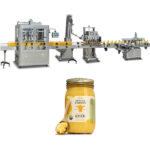What is Snap Cap/Lid?
A cap that is placed on a container without torquing is called a snap cap. A snap cap may be threaded or unthreaded. Snap caps snap onto the container over any threads, without requiring any torquing motion. Cleaning supplies, such as a canister of sanitizing wipes, are often fitted with snap caps. In addition, more flip-top lids are also snap-on lids.
Snap top caps are commonly used in food packaging and body care packaging;
Snap Caps for Food Packaging
When packaging a range of food products, like cooking oil, salad dressing, condiments, and more, choose snap top caps for easy dispensing. These snap top caps are offered in a variety of colors, are smooth or ribbed, and feature different types of liners to fit your needs.

Snap Caps for Body Care Packaging
Extensive range of unlined snap top caps for packaging body care products that could consist of shampoo, lotions, hair care products, and more. These snap top caps are durable, convenient to store, and easily dispense body care products.

What is a Snap Capper?
A snap capper is used to quickly and ergonomically apply push-on, press-on, or snap-on caps onto containers and bottles in various shapes and sizes. Thus, eliminating the tedious work of placing the lids by hand manually. They help prevent repetitive motion strains and injuries to your workers caused by the manual work of lid placement. Moreover, it removes human error to prevent costly spills.
Given the many types of caps that these machines can handle, they are also known by different names such as the following:
- Press-on capping machine
- Push-on capper equipment
- Snap-on capping equipment
VKPAK’s snap capper uses the latest technology to automatically place and accurately snap down most snap down cap types onto most bottle types. The snap capper can place and snap down flat caps, oval caps, safety caps, child proof caps, or with over-caps or induction seals. The snap capper can handle almost any bottle type or shape including PET, PP, PVC, HDPE, LDPE, and Glass.
Why Use a Snap Capper?
Snap capper not only increase the speed of the packaging process but also make sure that each lid is sanitary. They help prevent the contamination of the products unlike when they are manually capped. Moreover, they allow the operators to save themselves from the repetitive motions caused by the manual placement and tightening of the caps into the containers.
Snap capper machines not only save you time but also decrease your operating expenses by:
- Streamlining the cap placement process
- Getting your products ready for delivery at a faster pace
For instance, instead of your workers manually sorting or placing and tightening the lids onto the containers, you can just let the machine do all of these tasks. Aside from automating the packaging process, snap capper machines also produce more uniform and consistent results.
Types of a Snap Capper
Whether a packaging line is designed for high or low production speeds, it will oftentimes require some kind of assistance for capping the containers. The goal of opting for a capping equipment is not limited to increased production speed. Container cappers give reliable and consistent seals to fight against overly tightened caps, loose caps, crooked caps, product leaks, and spills.
Automatic Snap Capper
Automatic snap capping machines are produced to provide your packaging lines a continuous capping of your containers. Most of these machines are equipped with conveyor and cap delivery systems such as a vibratory bowl or an elevator. The setup and control of automatic snap capping machines are achieved using control panels along with necessary levers and finger knobs.
Moreover, the operator is required to provide bulk quantities of lids to the cap delivery system. But once the capper machine is fully set up and the caps provided, the only thing the operator needs to do is to monitor the machine while the capping process is ongoing.

Semi-Automatic Snap Capping Machines
The main difference between semi-automatic snap cappers and fully automatic ones are based on the mode of operation of each machine. For semi-automatic snap cappers, the operator needs to manually place the cap or closure on the containers before putting the cap-container combination into the snap capper equipment.
Snap capping machines usually use plungers or snap-on belts to apply the pressure needed to snap the lids into the bottles. Moreover, snap capper machine manufacturers often add spindle wheels to the snapping device creating a snap capper equipment that can both snap and screw caps onto containers. These combined machines work best for companies or packagers handling a wide range of containers.

Components of a Snap Capper
#1 Cap/Lid Sorter and Feeder
These components of the machine sort and feed the right lids into the machine. The cap sorter’s design depends on the geometry of the cap being used. On the other hand, the lid feeder can be a vibratory bowl or a cap elevator.
#2 Press On Head
Snap capper machines have press on heads used to press the snap caps onto the containers to tighten the lid. It can be a single or multiple press heads, or a chain plate.
#3 Chute Parts
The machine needs the capper chute for holding the lids in position. It places the lids on each container that passes through the end of the chute before the container goes under the press on head for the snapping process.
#4 Conveyor Belts
The conveyor belts are continuously moving metal or rubber that moves the caps and containers towards the capping zone. They are very important components of an automatic snap capper equipment for transport because the machine depends on the conveyor belts to transport the containers to and from one point to another in the machine. Furthermore, they firmly guard the containers in position while the capping process is ongoing.
#5 Gear Boxes, Drives, and Motors
These components are also referred to as the snap capping machine’s engine. Together, they assist the snap capper machine by serving as drivers for the machine’s other components. The speed of the movement of the components will be determined by the settings you set on the control panel of the capping machine.
#6 Pulleys
The pulleys are connected to the machine’s conveyor belts and gears which means that they also play an important role in moving the machine’s components. They come in various sizes depending on your snap capper machine’s design.
#7 Shafts and Sprockets
The shafts and sprockets work together and assist in transmitting rotary motion to the shafts. Similar to the motors, drives, gearboxes, and pulleys, these two parts of the machine help in driving the other components of the machine during the capping process.
How Snap Capper Work?
A snap can capper equipment simply snaps a lid onto a filled container. Basically, the working principle of both fully automatic and semi-automatic can snapper machines are the same. The only difference is fully automatic snap cappers will use a cap sorter, feeder, and chute while semi-automatic ones will not have these.
Step 1. Provision of lids to the fully automatic cap capper machine.
For the snap cappers, the operator provides snap lids in bulk quantities onto machine’s cap feeder. The lids should be compatible with the containers to be capped.
Step 2. Feeding the lid snap capper machine with containers.
The operator feeds the machine with the filled and uncapped containers which will move towards the capping station via a conveyor belt.
Step 3. Snapping the loosely placed lid tightly into the containers.
The press on head automatically presses the loosely placed lid onto the containers to secure a tight seal.
Step 4. End of the capping process.
The tightly sealed containers will continue moving towards the end of the capping line and ready for bulk packaging and delivery.
Factors to consider when buying a snap capper
At VKPAK, we make sure to determine your specific needs for your desired snap capper machines to produce a machine that would perfectly suit your business. The factors in the manufacturing process of your machine will be affected by the following:
- The type of snap can capping machine that you need
- The type of cans you are going to cap
- The type of caps you will be using
- The type of products you will be packaging
- Your product yield requirements
- Your factory’s size and layout
- Other additional requests
Customize Your Snap Capping Machine
At the initial stage of the customization of your snap capping machine, our expert engineers will be cooperating with you to tailor your machines based on your capping requirements. We help you create a reliable solution for your packaging lines and give you professional technical support for the installation, correction, and maintenance of your machines. All you need to do is talk to our experts and we will do the rest for you.
Customizable Components
After which we will ask you what you want to customize on your snap capper machine based on your needs. Don’t worry as we will help you in deciding the appropriate details that should be incorporated in your machines while still sticking to your special requirements. Having mentioned this, below are the machine components that you can customize in your snap capper equipment.
#1 The Whole Equipment Structure
You can customize the whole structure of your snap capper equipment according to the type of lid you are going to use to cap your containers. And to make your machine perfectly match the type of container you are packaging, you are required to give us a sample of your bottle.
#2 Your Equipment’s Production Speed
Decide what production speed you want your machine to have based on your factory’s capacity of production.
#3 Brand of Your Machine’s Electrical Parts
Select popular brands that you want us to use for the electrical parts of your ideal snap capper.
#4 Raw Materials For your Equipment
Choose the raw materials that you prefer from either #304 or #306 stainless steel.
#5 Snap Capper Machine Size
Customize your snap capper equipment’s size to fit your plant’s size and layout.
Summary
The snap capper uses either a press on head or press belt to apply pressure to snap on type caps as they move through the capping equipment. Automatic snap capper will use a delivery system, such as an elevator and chute, to deliver the closures to the containers just prior to the sealing process. Snap cappers work with a wide variety of snap on type caps, bottle types and bottle sizes.
VKPAK automatic snap capper machines apply push-on caps, press-on caps, and snap-on caps onto bottles and containers at speeds of up to 120 caps per minute. All of our automatic snap capping machines are constructed of stainless steel and anodized aluminum for excellent corrosion resistance, strength and durability.
If you are looking for a snap capping machine, please contact us, we are a professional packaging equipment manufacturer, our engineers will provide you with the best solution.








